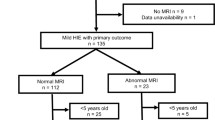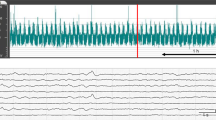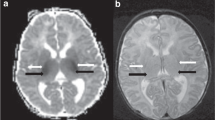Abstract
Objective:
Early identification of infants with hypoxic-ischemic encephalopathy who have adverse outcomes despite neuroprotection with therapeutic hypothermia (TH) is urgently needed. Recent studies have found limited value of amplitude integrated EEG (aEEG) for predicting short-term outcomes in this population. Other quantitative electroencephalography (EEG) variables reflecting EEG amplitude, such as EEG power, could provide early stratification of a high-risk cohort in this population. The aim of the study was to evaluate and compare early EEG power and aEEG as predictors of magnetic resonance imaging (MRI) injury in neonatal hypoxic-ischemic encephalopathy.
Study Design:
We conducted a retrospective cohort analysis of 78 encephalopathic infants treated with TH between January 2009 and April 2013. About 56 infants had no/mild injury on MRI (group A), whereas 22 had moderate/severe MRI injury (group B). Total EEG power (TEP) and aEEG were obtained soon after initiation of hypothermia and then compared for their ability to predict future MRI injury.
Results:
TEP, calculated at a mean age of 8.9 h, was significantly higher in infants in group A as compared to group B (71.6±64.8 vs 26.9±65.3, P=0.02). Odds ratios for predicting moderate-severe MRI injury for TEP<10 μV2, TEP<20 μV2, burst Suppression or worse aEEG pattern were 55 (confidence interval (CI) 6.4 to 471), 12.5 (CI 3.8 to 40.7) and 6.7 (CI 2.0 to 19.8), respectively.
Conclusion:
Early TEP is a reliable predictor of moderate-severe MRI injury in encephalopathic infants undergoing TH and may enable early stratification of infants who may benefit from adjuvant therapeutic interventions.
This is a preview of subscription content, access via your institution
Access options
Subscribe to this journal
Receive 12 print issues and online access
$259.00 per year
only $21.58 per issue
Buy this article
- Purchase on Springer Link
- Instant access to full article PDF
Prices may be subject to local taxes which are calculated during checkout



Similar content being viewed by others
References
Ferriero DM, Bonifacio SL . The search continues for the elusive biomarkers of neonatal brain injury. J Pediatr 2014; 164: 438–440.
Tagin MA, Woolcott CG, Vincer MJ, Whyte RK, Stinson DA . Hypothermia for neonatal hypoxic ischemic encephalopathy: an updated systematic review and meta-analysis. Arch Pediatr Adolesc Med 2012; 166: 558–566.
Jacobs SE, Berg M, Hunt R, Tarnow-Mordi WO, Inder TE, Davis PG . Cooling for newborns with hypoxic ischaemic encephalopathy. Cochrane Database Syst Rev 2013; 1: CD003311.
Rutherford M, Ramenghi LA, Edwards AD, Brocklehurst P, Halliday H, Levene M et al. Assessment of brain tissue injury after moderate hypothermia in neonates with hypoxic-ischaemic encephalopathy: a nested substudy of a randomised controlled trial. Lancet Neurol 2010; 9: 39–45.
McKinstry RC, Miller JH, Snyder AZ, Mathur A, Schefft GL, Almli CR et al. A prospective, longitudinal diffusion tensor imaging study of brain injury in newborns. Neurology 2002; 59: 824–833.
Briatore E, Ferrari F, Pomero G, Boghi A, Gozzoli L, Micciolo R et al. EEG findings in cooled asphyxiated newborns and correlation with site and severity of braindamage. Brain Dev 2012; 35 (5): 420–426.
Nash KB, Bonifacio SL, Glass HC, Sullivan JE, Barkovich AJ, Ferriero DM et al. Video-EEG monitoring in newborns with hypoxic-ischemic encephalopathy treated with hypothermia. Neurology 2011; 76: 556–562.
Murray DM, Boylan GB, Ryan CA, Connolly S . Early EEG findings in hypoxic-ischemic encephalopathy predict outcomes at 2 years. Pediatrics 2009; 124: e459–e467.
Jain S, Mathur A, Srinivasakumar P, Wallendorf M, Zempel J . Prediction of neonatal seizures in hypoxic-ischemic encephalopathy using EEG power analyses. Pediatric Neurol 2016 (in press).
Bednarek N, Mathur A, Inder T, Wilkinson J, Neil J, Shimony J . Impact of therapeutic hypothermia on MRI diffusion changes in neonatal encephalopathy. Neurology 2012; 78: 1420–1427.
Hellstrom-Westas L, Rosen I, de Vries LS, Greisen G . Amplitude-integrated EEG classification and interpretation in preterm and term infants. NeoReviews 2006; 7: e76–e87.
Korotchikova I, Stevenson NJ, Walsh BH, Murray DM, Boylan GB . Quantitative EEG analysis in neonatal hypoxic ischaemic encephalopathy. Clin Neurophysiol 2011; 122: 1671–1678.
Martinez-Biarge M, Diez-Sebastian J, Rutherford MAM, Cowan FMF . Outcomes after central grey matter injury in term perinatal hypoxic-ischaemic encephalopathy. Early Hum Dev 2010; 86: 675–682.
Shankaran S, Barnes PD, Hintz SR, Laptook AR, Zaterka-Baxter KM, McDonald SA et al. Brain injury following trial of hypothermia for neonatal hypoxic-ischaemic encephalopathy. Arch Dis Child Fetal Neonatal Ed 2012; 97: F398–F404.
Bell AH, McClure BG, Hicks EM . Power spectral analysis of the EEG of term infants following birth asphyxia. Dev Med Child Neurol 1990; 32: 990–998.
Acknowledgements
SJ is funded by Neurological Sciences Academic Development Award at Washington University in St Louis (5K12NS00169018). We would also like to acknowledge the Thrasher Foundation and Intellectual and Developmental Disabilities Research Center (IDDRC—Washington University in St Louis) for their funding support. The funding organizations had no role in design and conduct of the study or collection, management, analysis and interpretation of the data or preparation, review or approval of the manuscript or decision to submit the manuscript for publication.
Author contributions
SJ was involved in design and conceptualization of the study, analysis and interpretation of data, and drafting the manuscript. JZ was involved in conceptualization of the study, interpretation of the data and revising the manuscript for intellectual content. PS was involved in data collection and revising the manuscript for intellectual content. MW conducted the statistical analysis. AM was involved in conceptualization of the study, interpretation of the data and revising the manuscript for intellectual content.
Author information
Authors and Affiliations
Corresponding author
Ethics declarations
Competing interests
The authors declare no conflict of interest.
Rights and permissions
About this article
Cite this article
Jain, S., Zempel, J., Srinivasakumar, P. et al. Early EEG power predicts MRI injury in infants with hypoxic-ischemic encephalopathy. J Perinatol 37, 541–546 (2017). https://doi.org/10.1038/jp.2016.262
Received:
Revised:
Accepted:
Published:
Issue Date:
DOI: https://doi.org/10.1038/jp.2016.262
This article is cited by
-
Improving child health through Big Data and data science
Pediatric Research (2023)



